2011 Kia Sportage – click above for high-res image gallery
The crossover is the high-fructose corn syrup of the automotive world. Think about it: Rather than using real sugar, Pepsi opts for a cheaper, highly refined and processed sweetener. Which, according to lots of studies, is pretty bad for us. Why would they do that? Higher profits, pure and simple. Likewise, CUVs offer all of the space of a comparably long station wagon or hatchback, get inferior mileage, don't handle as well, take longer to stop and in most cases offer none of the utility of a true off-roader. But guess what? They pull in fistfuls of greenbacks for auto companies.
Like high-fructose corn syrup then, car experts ("Hi, Mom!") can scream out their lungs until they're blue about the benefits of a more sensible, safer, smarter product (again, wagons). Yet consumers simply don't listen. The fastest growing automotive segment is – of course – the small CUV. Like the Snickers bar, the Twinkie and a twenty-piece Chicken McNuggets meal with BBQ sauce (all of which is mostly corn syrup), they are here to stay, forever. Buyers just seem to like the looks and the perceived safety that a high-riding vehicle affords them. Plus, for those with infant children, not having to stoop down to strap Junior into his car seat is the most luxurious feature on earth. With all that in mind, some CUVs are better than others – and not only in terms of looks, but also handling, packaging, content and value. Is the new 2011 Kia Sportage one of them? Read on to find out.
Photos by Jonny Lieberman / Copyright ©2010 Weblogs, Inc.
The Sportage is arguably the Granddaddy of the CUV craze, as it was initially launched in 1996. That may not seem like a long time ago, but consider that the little Kia trucklet showed up before the Toyota RAV4, Honda CR-V or Ford Escape. Of course, when the Sportage initially arrived, the diminutive softroader packed a puny, 92-horsepower engine along with an archaic body-on-frame construction. In reality, the Sportage was actually an SUV, but it was one that wasn't terribly good at the roly-poly stuff. It looked a little funny, too. However, the Sportage proved to be a huge success for Kia, allowing them to offer customers a very inexpensive entry into the late-90s SUV-craze. In fact, the Sportage remains so integral to Kia's U.S. efforts that it's the only nameplate in the company's stockpile from the 1990s that's still on sale.
But while the Kia Sportage has always been cheap, it hasn't been particularly good – especially in the aesthetics department. But as you've no doubt noticed, there's a new design sheriff in Kia-town – Peter Schreyer, the man behind the Audi TT and Volkswagen New Beetle – and he's already made taken some big strides at Kia. Specifically with the Forte, Koup and Sorento. Now comes the 2011 Sportage and it's easily the best looking of the bunch. Designed in California and featuring Kia's signature bowtie grille (no, not that one), the Sportage is instantly recognizable as a Kia – to those who know what one looks like. Obviously, the reason for such strong design language (and to hire a superstar like Schreyer) is to make the brand more recognizable. We think Kia is well on their way, and like the Forte and Koup before it, this newest vehicle is leading the way.
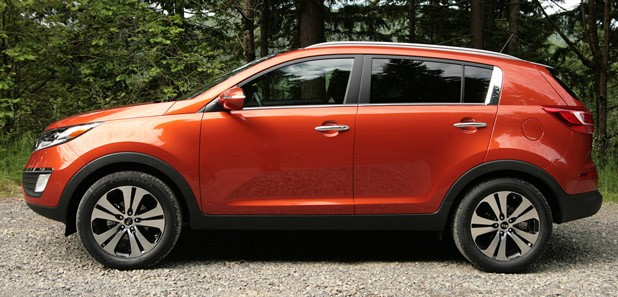
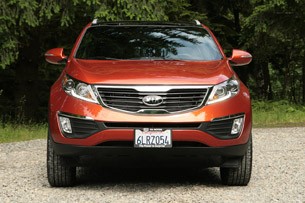
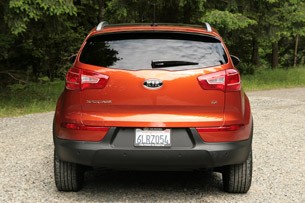
Kia wants consumers to think of the Sportage as "a sports car wearing a backpack." A bridge too far, perhaps, but not entirely left field. The Sportage's target demographic is young, single men, the same sort of folks that purchase sports cars. Kia figures the Sportage will slot in between the smaller, cheaper Soul and the larger, seven-passenger, more family oriented Sorento. Even though the Sportage is clearly not a sports car (backpack or not), it does offer a number of sporting and even upscale touches that might just tickle a young man's fancy. For instance, it has LED running lights below the headlamps, exactly like an Audi R8 (a fact which no doubt has Ingolstadt's brand managers spitting nails in anger). Kia's also seen fit to include LED turn-signal repeaters in the side mirrors, another cue taken from pricier machines. Other thoughtful touches abound, including rear-parking assist, back-up camera, dual-zone climate control, ionized filtration A/C, a cooled glove box, a giant panoramic sunroof and a bottom-hinged throttle pedal, just like a Porsche. That last item is particularly appreciated by us.
The interior is about on par with the rest of the segment. Plasticy but fine, though people who really care about a finely finished interior will have to save their nickels for an Acura RDX. That said, the Kia's plastics are at least the non-greasy kind and our test vehicle had the bright orange accents and door panels that greatly helped break up an otherwise totally black cockpit. And the cross-stitched leather-wrapped steering wheel is quite excellent, CUV or otherwise.


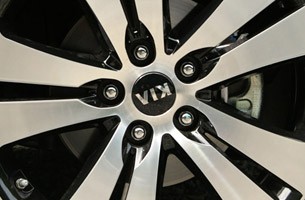
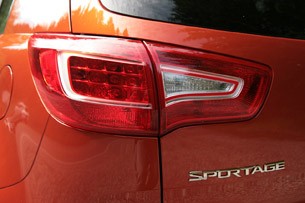
Electronically speaking, top end Sportage models get either the nav-stereo system Hyundai uses for cars like the Genesis Coupe or Kia's brand-new UVO connectivity system. Think of UVO as Kia's version of Ford's SYNC. Both systems ride atop Microsoft's Windows Embedded Automotive operating system, or WEA for short. Like Sync, UVO (which stands for "Your Voice" and is pronounced, "You-Voh") lets you connect your Bluetooth capable phone to the car's infotainment system. Then, using just "your voice" you can place calls and even respond to text messages. Sadly, like SYNC, you're forced to use canned replies – though with UVO, at least you can customize those replies.
The biggest difference between UVO and SYNC is that UVO will let you just say, "Play Led Zeppelin Black Dog," whereas SYNC currently requires an intermediary step where you must first say, "iPod," then the artist and track information. The UVO idea being that you might have "Black Dog" on your phone, a CD, your iPod, a USB stick or the Sportage's built-in hard drive. That being the case, UVO searches all of your media sources, finds the song you want then plays it. Pretty slick.

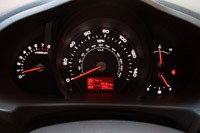
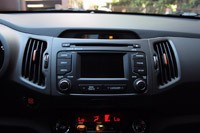

In theory, totally. Sadly, all the UVO-equipped cars we drove were pre-production – both the Sportages themselves and the UVO units. Out of about fifty attempts to get UVO to work using our voices, two were successful. Are we panning it? We should, but we're not – but only for one reason: As UVO shares the same operating system as SYNC, it has the potential to be an industry leader. Not only that, but the head of Kia's Connected Car unit is Henry Bzeih, a former SYNC engineer at Ford. We're therefore confident that Kia will get UVO working properly before it reaches consumers. For now, however, the jury remains unhappy – and they had better get it working, as going forward, all future Kias will have UVO as an option.
But enough gizmology. How's the Sportage drive? Solidly, like a sportier version of the Hyundai Tucson, a vehicle that impressed us with its firmly tuned suspension and near-athletic moves. This should come as no shock: The Sportage and the Tucson share the same basic architecture. Compared to the previous Sportage, however, the difference is night and day. The new model is three inches longer, two inches wider, but just over two inches closer to the ground. Amazingly, it's also 200 pounds lighter than the outgoing model, though we suspect that figure is compared to the outgoing V6, and the 2011 Sportage can only be had with a four-banger. But here's the good news: the new 2.4-liter inline-four produces more horsepower than the old 2.7-liter V6 – 176 hp compared to 173 ponies. Torque is down a bit, however, from 178 pound-feet in the V6 to just 168 lb-ft from the 2.4-liter. And to hear Kia officials tell it, the Sportage will never be available with a V6. It will, however, be offered with Hyundai's 2.0-liter twin-scroll turbo motor, which should produce somewhere around 270 hp and 270 lb-ft of twisting force. Who needs those extra cylinders?
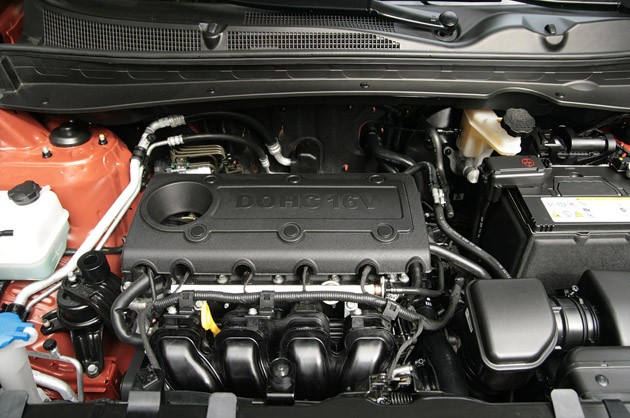
Back to the powertrain we actually drove. The grunt is enough to move the Sportage about in a quick – if not genuinely brisk – manner. Sports car? Again, not really. But definitely quick enough to easily merge onto highways and provide good entertainment when the going gets twisty. Just don't concern yourself with top speed. Speaking of which, the Sportage's suspension is set up unusually well for curving road duties. Up front, you'll find MacPherson struts and out back there's a multi-link configuration. For reference, the much-lauded BMW 3 Series is set up much the same way. The Sportage, then, can actually live up to its name. And there's more handling to come.
Remember the turbocharged engine we mentioned? It will ship with firmer, sportier shocks called HPD (high performance dampers). As it happens, the prototypes we drove around Washington state actually had the HPD shocks installed, so like UVO we'll have to wait for a production version to get the entire story. You can also opt for an on-demand all-wheel drive system that features a center-locking differential as well as the ability to "predict" conditions (i.e. use the traction control system to notice slip) and route torque front-to-back appropriately. We drove one AWD Sportage on smooth, dry roads from Redmond to Seattle, WA and noticed no handling difference between it and its front-drive counterpart.
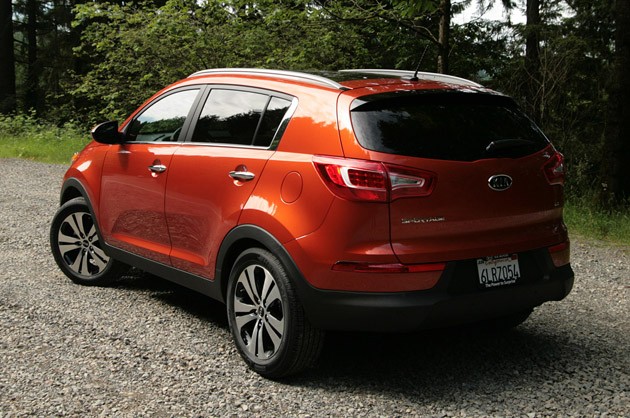
On the negative side of things, the examples we drove felt pretty twitchy, with a ride quality that was sometimes jarring on bumpy, truck-worn freeways. It was also hard to keep one of them pointed straight. Again, these were pre-production vehicles. Moreover, the CUVs we drove were late coming in from Korea. So not only did the cars feature the wrong dampers, but Kia wrenches were actually changing out engine mounts the night before we arrived. As a result, all three of the Sportages we drove had different behaviors. This was most noticeable in each CUV's various steering feel. One was a bit slack on center, another felt under-boosted, and still the third had even more slack on center – until we ran into/over a curb while trying to negotiate a traffic circle. Oddly, that jarring bump seemed to clear the problems up. Like the Tucson and most Kia/Hyundai products going forward, the Sportage features electronic assist power-steering, which is one reason why it manages 22 miles per gallon in the city and an impressive 31 mpg highway. However, electronic power-steering needs to be tuned to the tastes of the target market and again, we don't feel these pre-production vehicles were adequately tuned at all. Like UVO, we have faith that Kia will get everything sorted out by the time the Sportage goes on sale later this summer.
We know that a review of a not-ready-for-prime-time player isn't the most useful piece of consumer information ever written. Trust us, Kia knows this, too. However, assuming that the kinks get worked out of the production cars – and they've pledged to do just that – what we've got here is a pretty compelling, good-looking, sporty handling, inexpensive crossover. Kia isn't set on the numbers just yet, but they say that pricing should fall in line with the current Sportage. Figure a stripped-out base price of just under $17,000 with a fully-loaded AWD and UVO example going for around $25,000. Like its cousin the Hyundai Tucson, this represents great value when compared to competition like the RAV4, CR-V and Escape, especially as the Sportage looks remarkably better than all of them – including the Hyundai. While we still maintain our starting mantra against CUVs as a segment, Kia's new Sportage is pretty easy to swallow.
Photos by Jonny Lieberman / Copyright ©2010 Weblogs, Inc.
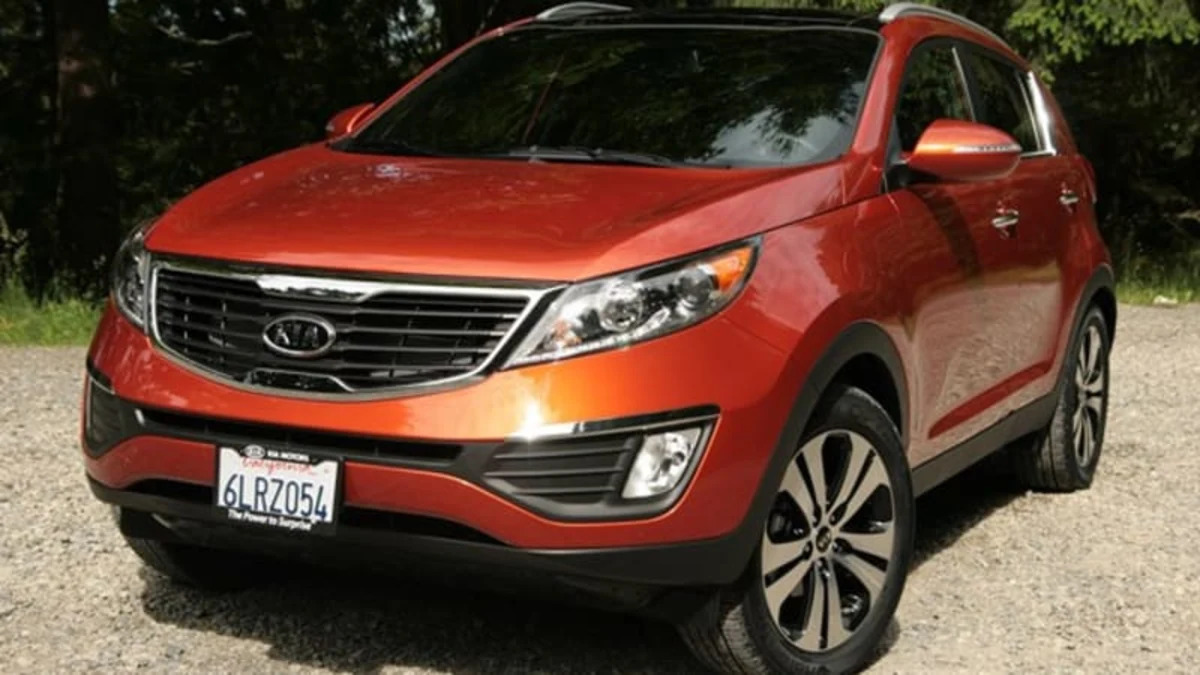


Sign in to post
Please sign in to leave a comment.
Continue